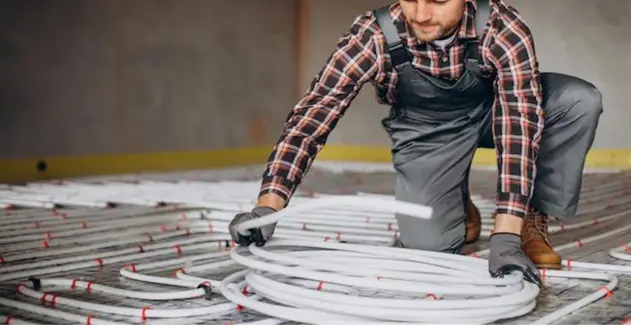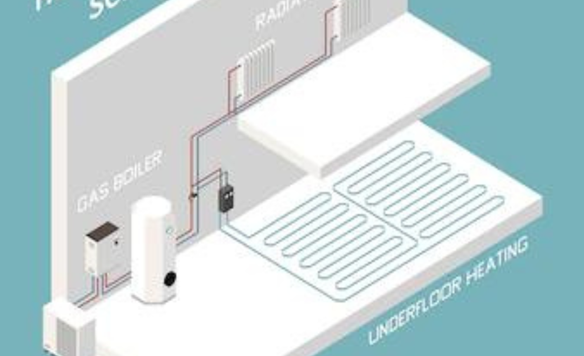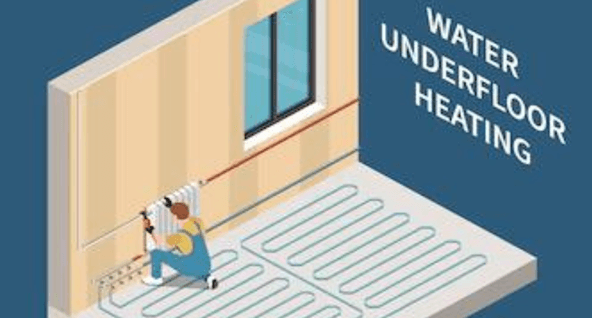Did you notice that radiators are now being widely replaced by underfloor heating systems because of increased heating efficiency? Since the Victorian times, radiators have been used to warm up spaces but now, they are being displaced by radiant underfloor heating as it is eco-friendly and uses less energy compared to traditional radiators.

If you want to learn more about underfloor heating, radiators, and which will be better for your home, keep on reading this blog because we’re outlining the benefits of underfloor heating for you.
Let’s dive in!
What is underfloor heating?
Underfloor heating is a way of heating a place through tough and flexible tubing that is implanted in the floor. There are two types of underfloor heating UK systems.
- Water-based (hydronic) underfloor heating – Pipes are embedded in the floor and when the heat supply is switched on, warm water circulates through the tubes to heat the floor.
- Electric underfloor heating – Heated cables, either in loose wire form or embedded into a mat, which run on a domestic electricity supply to warm up the floor above.
What is a radiator?
A radiator runs on the principle of convection by raising the heated air toward the ceiling and the air that has cooled down descends downwards to be reheated by the radiator. This usually creates a flow of warm and cool air around the room which helps in the spreading of heat.
Radiators are usually made up of cast iron, steel, or aluminum. Radiators for central heating comprise two panels, connected by a top grille and side panels.
Underfloor Heating vs Radiators
Everything has pros and cons, so how to choose which one will be better? How can you choose between underfloor heating vs radiators for heating your home?

Let’s have a detailed look at the pros and cons of both underfloor heating and radiators to make it easier for you.
Also Read:
- What is Induction Heating?
- What is Heat Sink And How It is Made?
- What is a Cooling Tower and How it Works?
Underfloor Heating
Some benefits of underfloor heating are.
- It warms up all the spaces in the room leaving no cold spots or draughts creating a comfortable environment.
- It is controlled by a thermostat so you can easily set it to your preferred temperature.
- It is 25% more efficient than radiators as it covers a larger surface area; it uses lower water temperatures and consume less domestic electricity to heat the floor.
- It provides a feeling of warmth and comfort to the underfoot.
- It occupies less space and as it is beneath the floor, it is invisible to the sight of visitors making the home look cleaner.
- It doesn’t have any type of exposed heated parts or surfaces which may be a cause of injury.
- It works with all types of floor finishes such as laminate, wood, tile, stone, carpet, etc.
- It can last for up to 50 years if the setup is well-maintained.
Some disadvantages of Underfloor heating are.
- The installation cost of Underfloor heating is higher because it requires more parts and has a longer installation process than radiators, but underfloor heating is only a one-time investment helping you save money in the longer run.
- Underfloor heating is not well-known so, you may need to learn how to handle them properly.

Radiators
Advantages of Radiators.
- Radiators are common, so installing them is an easy task.
- Radiators are cheaper so if you are renovating or are on a budget, it may be a good choice.
- Radiators are easier to maintain.
Disadvantages of Radiators.
- Radiators don’t supply heat efficiently and evenly across the room, there may be uneven heat, cold spots, or draughts.
- Radiators occupy wall space as mostly metal heat radiators are installed on the wall.
- Radiators are not energy-efficient as they are only able to heat a small area of the house at a higher temperature (70-90°C).
- Exposed hot surfaces and sharp corners may cause injury or burns.
- Radiators last for approximately 8 to 10 years before significant drop in performance.
While the Underfloor heating vs radiators debate is ongoing, by looking at the pros and cons of the radiator and underfloor heating UK systems, you can easily choose the best type of heating system for your house to keep it warm and full of comfort.
Could underfloor heating and radiators be used together?
Yes, the underfloor heating system and radiators can be combined to effectively heat your home.
An underfloor heating system can be installed in some rooms such as the living room where you spend all day while a radiator can be used in the bathroom or bedrooms where you just go for a shorter time.
Both heating systems can be successfully installed in a house to ensure effective heating. Moreover, it is easy to install an underfloor heating alongside an existing radiator.
How to choose the right company for your underfloor heating project?
Choosing the right company for your underfloor heating installation might seem to be a difficult task but some aspects to keep in mind before choosing the right contractor or company are.
- Great customer service – A company that satisfies and considers the needs and ideas of customers.
- A bespoke design – A company that has a strong understanding of Underfloor heating, so that the underfloor heating system is installed perfectly and heats the house efficiently.
- Lifetime technical support – A company that provides lifetime technical support so, you don’t have to deal with the maintenance of underfloor heating

The Bottom Line (Our Conclusion)
Underfloor heating is the most energy-efficient way of warming up your home. However, the installation cost is much higher as compared to radiators, but it uses less energy so, helping you save in the longer run.
Radiators are useful if you live in an older, less insulated properties with a lot of draft as the higher output temperature would help keep it warm quicker.
So, what are you waiting for? Find the right company and go ahead with finding the best heating system for your home.
Best of luck!





